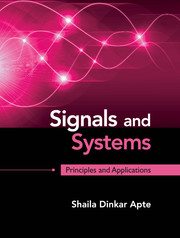Book contents
- Frontmatter
- Dedication
- Contents
- Preface
- 1 Introduction to Signals
- 2 Signals and Operations on Signals
- 3 CT and DT Systems
- 4 Time Domain Response of CT and DT LTI Systems
- 5 Fourier Series Representation of Periodic Signals
- 6 Fourier Transform Representation of Aperiodic Signals
- 7 Laplace Transform
- 8 Z Transform
- 9 Random Signals and Processes
- Index
3 - CT and DT Systems
Published online by Cambridge University Press: 05 May 2016
- Frontmatter
- Dedication
- Contents
- Preface
- 1 Introduction to Signals
- 2 Signals and Operations on Signals
- 3 CT and DT Systems
- 4 Time Domain Response of CT and DT LTI Systems
- 5 Fourier Series Representation of Periodic Signals
- 6 Fourier Transform Representation of Aperiodic Signals
- 7 Laplace Transform
- 8 Z Transform
- 9 Random Signals and Processes
- Index
Summary
This chapter concentrates on system definition and properties. The properties of systems such as linearity, time invariance, causality, invertibiity, memory and stability are discussed in detail. We have discussed sampling in chapter 1. The reader is already familiar with CT and DT signals. We will define properties of CT and DT systems simultaneously. Finally, we will see how to represent a system as an interconnection of operators and series/parallel; connection of systems.
Properties of CT and DT Systems – Linearity and Shift Invariance
We will discuss and explain properties of CT and DT systems in the following sections. We will study the property of linearity and Shift/time invariance in this section.
Linearity property
Any CT or DT system is said to be linear if it obeys two important properties. The first is homogeneity and the second is additivity.
Homogeneity property
The system is said to obey the property of homogeneity if the following condition holds:
• For CT and DT input signal of x(t) or x[n], respectively, if the output is given by y(t) or y[n], then if the input signal is scaled by a factor of k to get input signal of kx(t) or kx[n], then the output is also scaled by the same factor k i.e., output is ky(t) or ky[n], where k is any scaling factor. Let H represent the system operator, then
• if y(t) = H[x(t)] then ky(t) = H[kx(t)] and
• if y(n) = H[x(n)] then ky(n) = H[kx(n)]
Additivity Property (Superposition Property)
The system is said to obey additivity property if the following condition holds good.
• Let y1(t) and y1[n] be the output for the CT and DT input signal x1(t) and x1[n], respectively, and y2(t) and y2[n] be the output for input signal x2(t) and x2[n], respectively, for a CT and DT system. The property of additivity states the following:
If the input to a system is the addition of two signals, then the output of the system is the addition of the respective outputs. Let H represent the system operator, then
• If y1(t) = H[x1(t)] and y2(t) = H[x2(t)], then
y1(t) + y2(t) = H[x(t) + x2(t)]
If y1(t) = H[x1(n)] and y2(n) = H[x2(n)], then
y1(n) + y2(n) = H[x(n) + x2(n)]
- Type
- Chapter
- Information
- Signals and SystemsPrinciples and Applications, pp. 181 - 245Publisher: Cambridge University PressPrint publication year: 2016



